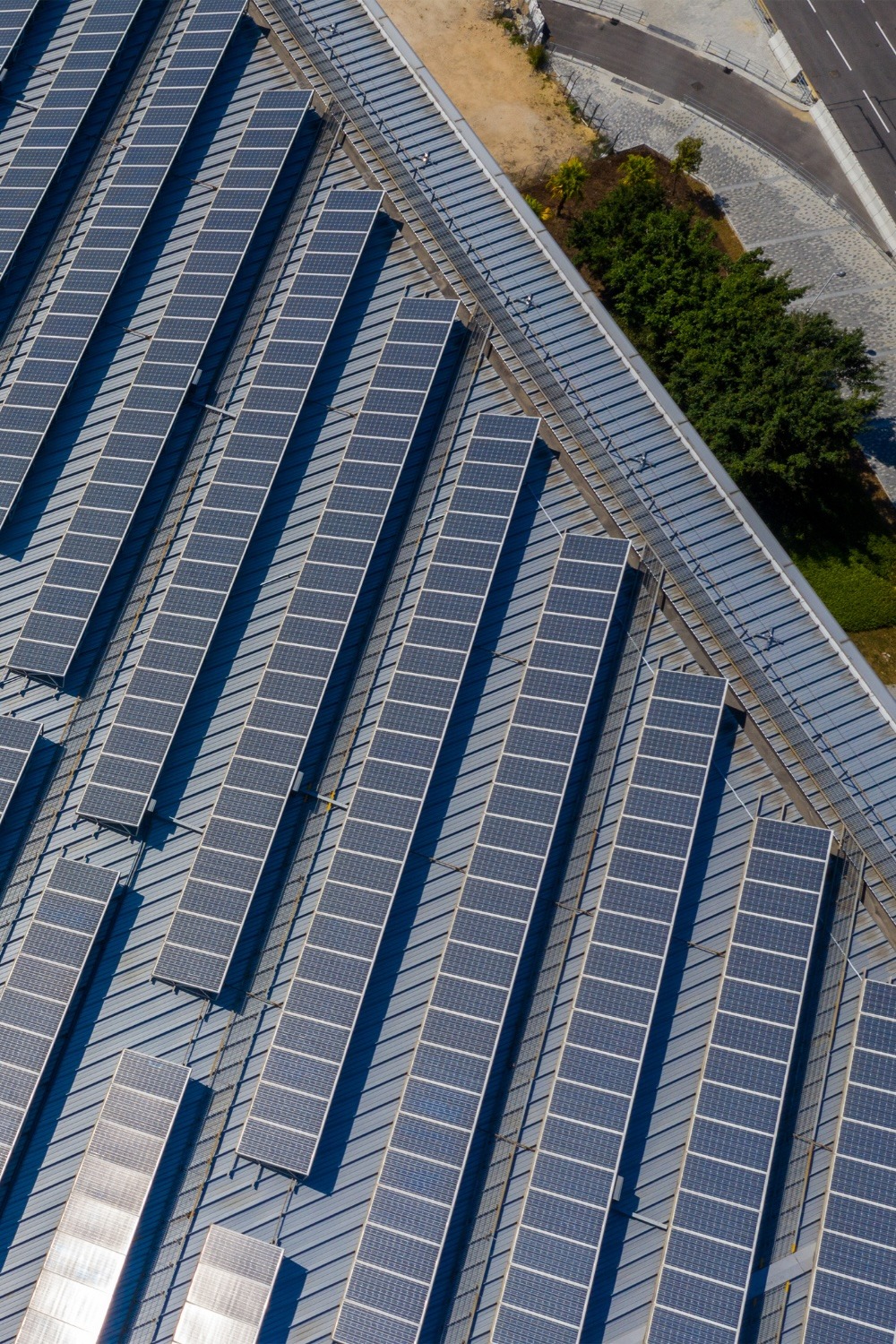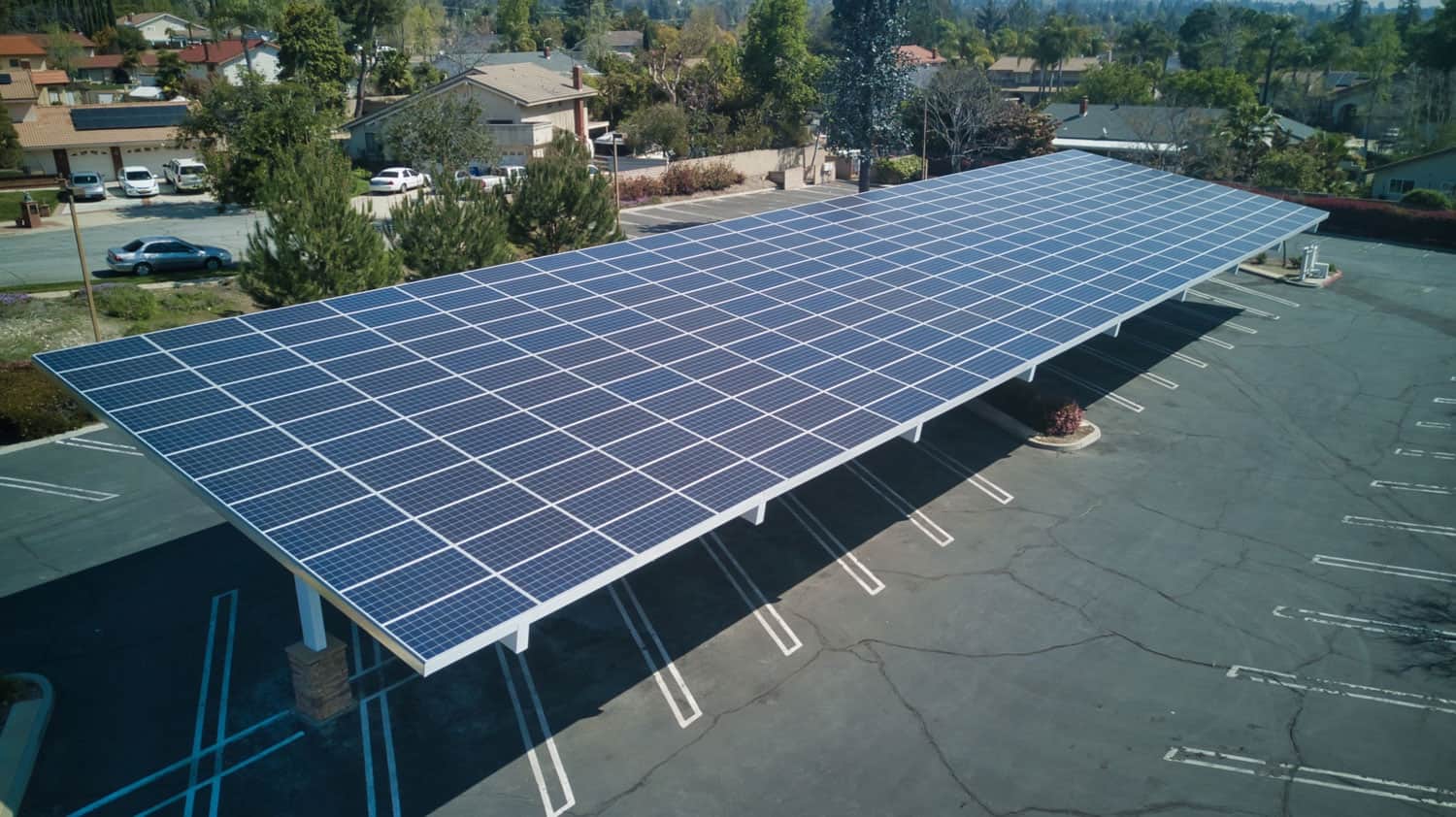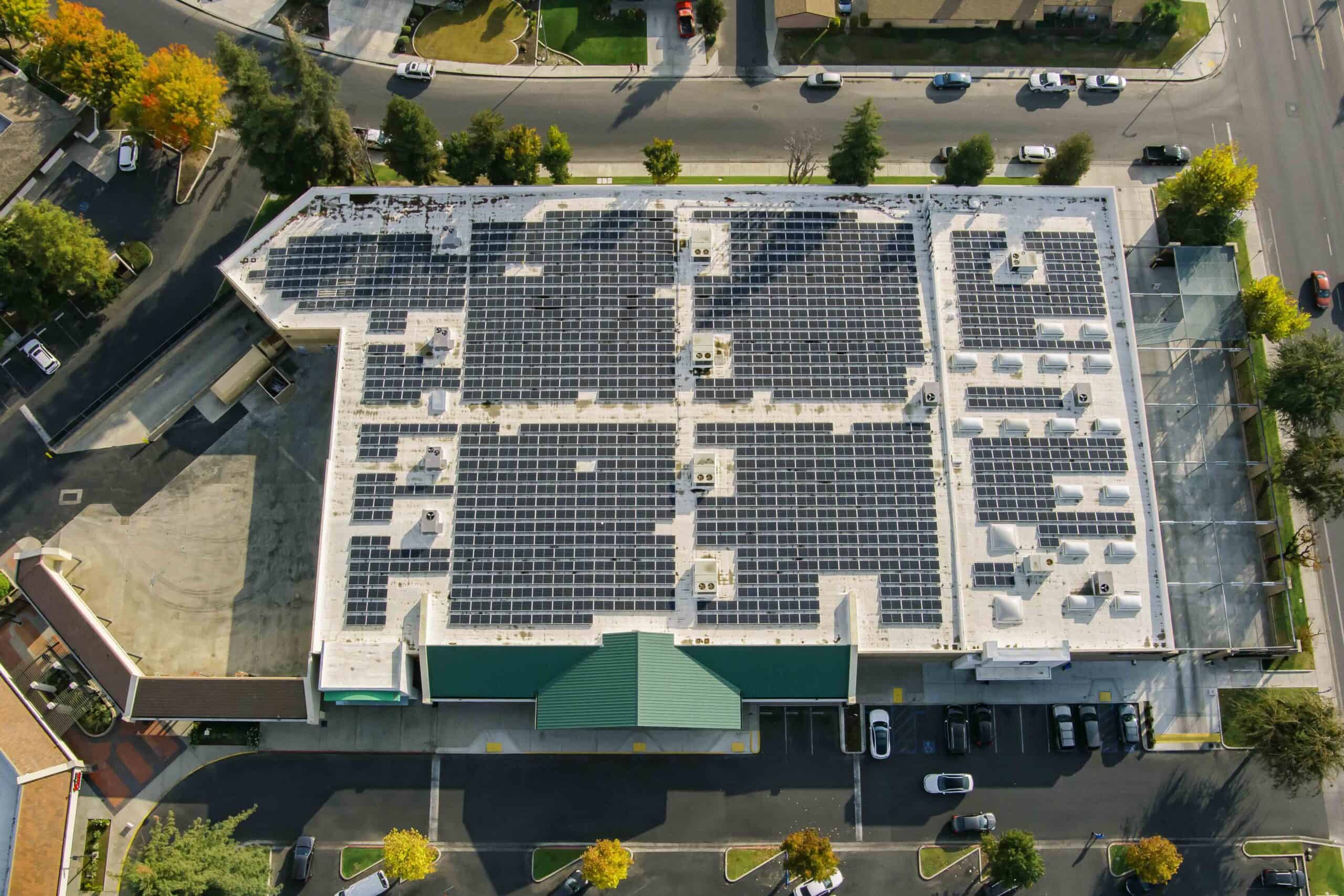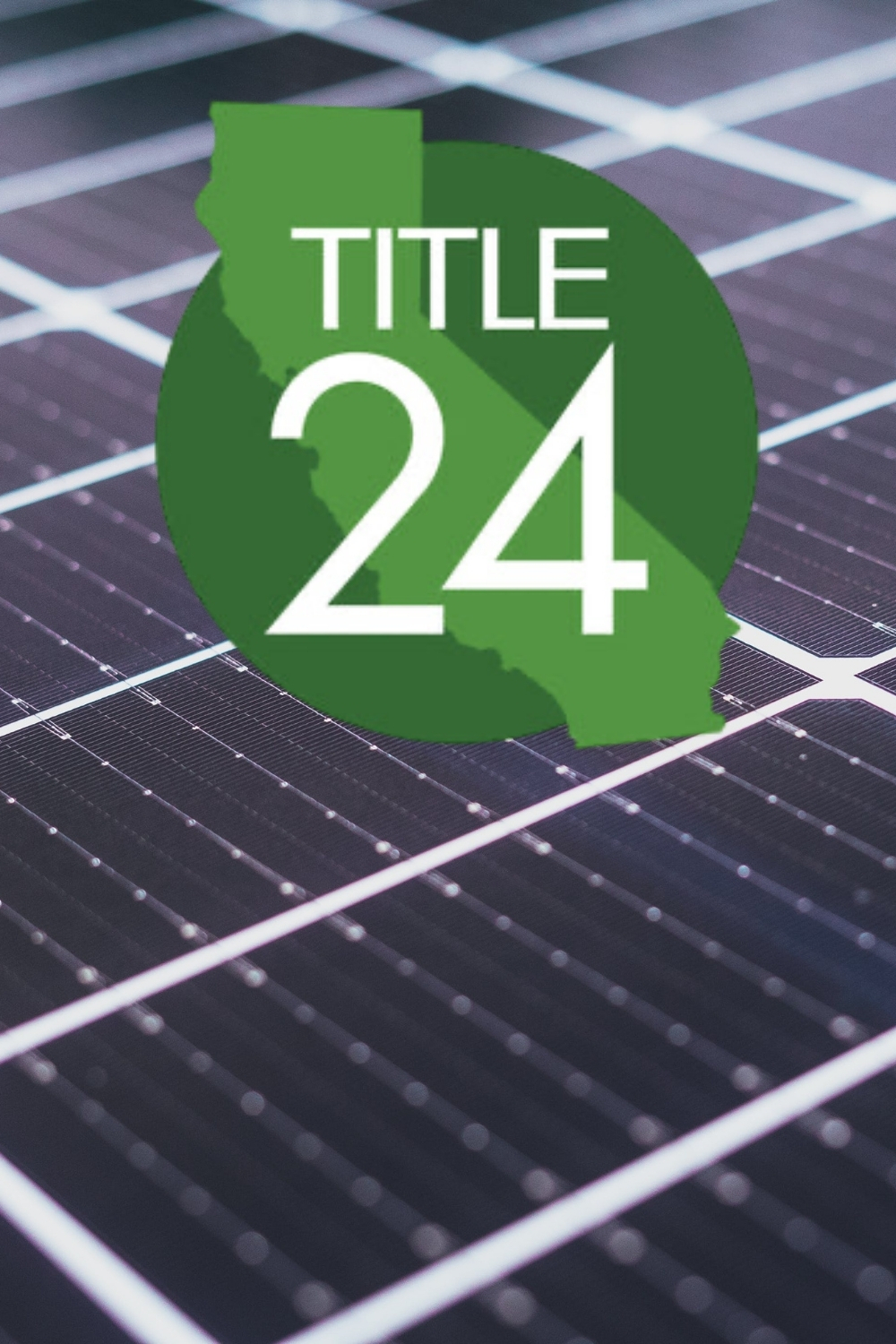For solar to be adopted consistently across commercial properties, there must be a credible and meaningful financial benefit to commercial property owners.
Until recently, a model did not exist to provide this benefit. However, a financial model has emerged that provides predictable, long-term income to property owners. This structure is known as a solar rooftop lease.
Solar leases are a no-cost way to bring solar power to commercial properties in a way that increases long-term Net Operating Income (NOI). In this article, we’ll dive into what solar leases are, how they work, and why they’re a great choice for commercial and industrial properties.
What is a Solar Lease?
A solar lease is a structure where a solar developer engages with a commercial property in the same manner as every other tenant: by leasing space and paying monthly rent. The key difference is that the space being leased is typically unused areas of the rooftop (or in some cases areas of the parking lot, where solar carport canopies can be deployed). Like any other tenant, the solar developer pays rent, manages their leased space and is expected to operate in a way that does not impact other tenants.
Solar leases typically have 20-to-25 year terms, and are especially useful for commercial properties like office buildings, shopping centers, and industrial buildings, which often have large, flat roofs that are perfect for solar panels at scale.
A key component of a solar lease is that there is no cost, or tenant improvement expense, borne by the property owner. The program is installed fully at the expense of the solar developer. The solar developer will also cover the maintenance costs of the solar program over its lifetime. Additionally, if any work is required to connect the solar program to the existing roof, the solar developer will hire the property owner’s preferred roofer to perform this work at the solar developer’s expense.
In many solar leases, the energy generated from the solar program will be provided to on-site tenants at a discount below the cost of energy from the local utility. This creates an additional financial benefit to the property.
In summary, a solar lease is a no-cost program to the property owner that creates a new source of long-term rent and benefits local tenants through cost savings on their energy bills.
How Does a Solar Lease Work?
Engaging in a solar lease for a commercial property is a relatively simple process. Here’s a step-by-step look at how it typically works:
1. Initial Assessment
First, a solar company will look at the property. Using satellite imagery and modeling software, they will check roof size, how much sun the property gets, and how much electricity the building typically uses.
2. Proposal and Initial Design
If the property looks like a good fit for solar, the solar developer will create an initial design that shows where solar panels may be deployed on the property, accompanied by a proposal for rent that will be paid. . As a part of this process they may visit the property to review the roof condition and to evaluate the existing electrical equipment.
3. Diligence and Project Validation
If the financial proposal is attractive to property ownership, the solar developer will complete further project diligence.
This diligence process typically involves some, or all, of the following steps:
- Validation with the local utility that there is adequate capacity on the local electrical grid to support interconnection of the program
- Completion of an application with the state’s community solar program
- Confirmation that the requirements of the local county, city or township are being met
- Review of the roof by a third-party roofing expert
These diligence steps are completed by the solar developer, at the developer’s expense. Based on the findings, it is possible that the solar program design may be revised to incorporate feedback from the utility, local authorities or the roofing expert.
In parallel to the diligence steps, property ownership typically reviews the solar lease agreement and confirms that the terms and conditions are acceptable. Also, the solar developer will work with its financing partners to confirm that the proposed project is consistent with the financing criteria needed to fund the program.
4. Lease Execution
After completion of the diligence review, both the solar developer and the property owner will have a high degree of confidence the program can proceed as scoped.
At this point, both parties will review, finalize and execute the lease agreement, which formalizes the process of the solar developer becoming a tenant at the property.
5. Project Financing, Solar Product Procurement, System Design and Permitting
As mentioned above, the solar developer will validate the program and lease structure with its financing partners during the diligence process.
After lease execution, the developer will formalize the financing for the program which will allow the developer to draw funds and place a procurement order for the solar components. Since most commercial solar programs involve an investment of $1 Million, or more, this financing and procurement process is an important step before the installation can take place.
In parallel to the procurement process, the developer will create a detailed program design that will be submitted to the local authority for permitting. The permitting process involves an engineering review of the program’s structural and electrical design.
6. Installation
After permits are approved and the solar components have been procured, the solar panels and related equipment will be delivered to the site. The solar developer will require a small staging area in the parking lot, but the solar equipment is typically transported up to the rooftop as soon as it arrives, which minimizes the space required at the ground level.
The solar panel installation process typically takes a few weeks, making it one of the shorter parts of the overall project plan.
7. System Activation
Once the solar program is fully installed, it is common that it may still take multiple weeks, or months, for the local utility to complete its reviews of the system before formal activation.
After a thorough review by the utility, the program is granted Permission to Operate, or PTO, and begins generating energy.
8. Ongoing Maintenance
During the lifetime of the program, the solar developer will handle the maintenance and upkeep of the solar program. Monitoring software will allow the developer to remotely track the performance and output of each solar panel, so an on-site visit to address issues is only needed when a performance problem is identified.
Once or twice a year the developer will perform a cleaning of the panels, as this ensures the optimal production of energy.
9. Quarterly Business Reviews and Reporting
Some solar developers will provide ongoing metrics and reporting to property ownership, which shares the financial and sustainability benefits created by the solar program.
The quarterly review will provide information on energy generation, tenant usage, and more. This can be helpful for investment groups looking to achieve green building certifications or meet ESG goals related to scope 3 emissions.
How Does a Solar Lease Impact Property Value?
Unlike other solar financing options, a lease has a measurable impact on property value. Like a lease with any other tenant, the solar lease increases a property’s long-term rent roll, which directly impacts the value of the property.
The following is a brief summary of how property value is increased through a solar lease:
- A solar lease increases a commercial property’s Net Operating Income (NOI). The rent from the system increases the property’s monthly revenue without changing operating expenses.
- Because it is a long-term lease, it directly increases the long-term rent roll of the property. This creates a secure, forecastable source of revenue for the building.
- The increased NOI and rent roll create a proportionally equivalent increase in the property value. Many owners and investors calculate property values by dividing their rent roll by their capitalization rate.
By creating measurable increases in key financial metrics, leasing solar panels can materially increase a commercial property’s resale value.
What are Other Benefits of Solar Leases?
Solar leases bring more to the table than increased property value and rent roll. Here’s a deeper look at some other key benefits:
Lower Energy Costs
With a solar lease, both tenants and common areas see reduced prices and lower overall energy bills. For commercial properties with high energy consumption, these savings can be substantial. They can make a big difference for tenants looking to save where they can.
No Service Costs
Unlike some other financing options, the solar developer pays all costs associated with the solar array. This means everything from application fees to cleaning costs. They’ll also handle scheduling maintenance and service of the solar energy system.
Reduced Carbon Footprint
The solar program generates renewable energy that will benefit the local community. A typical commercial solar installation can offset hundreds of tons of carbon dioxide emissions each year—equivalent to planting thousands of trees. Furthermore, generating energy locally decreases the need to transport energy over long distances, decreasing strain on the local power grid.
Sustainability Reporting
Most solar leases come with comprehensive monitoring systems that provide detailed information about energy production and consumption. This can help owners better understand their property’s energy usage and report on ESG metrics.
What are Key Considerations for a Solar Lease?
Solar leases offer significant financial benefits to commercial properties, but there are several important factors that owners must consider to ensure program success. A reputable solar developer will typically address these points and assist owners in creating a program that best fits their property and tenant mix.
Property owners should consider these items while exploring solar leasing options:
Roof Integrity and Warranty
The roof condition is a critical factor for the success of solar installation. It’s essential to ensure that the solar project’s installation doesn’t compromise your roof’s integrity or its warranty.
A well-structured solar lease should include provisions for protecting the roof. This may involve using specialized ballasted mounting systems or including terms governing removaling and re-installation of panels to allow for necessary roof maintenance. It’s recommended to engage with a solar developer that works with the property’s roofing contractor to ensure the solar installation doesn’t invalidate the roof warranty.
Additionally, some solar developers will require that the roof be in brand new condition. Others will install on a roof that has 7 to 15 years of life left, and temporarily remove the solar system when it is time to replace the roof. The latter approach provides more flexibility to property owners who have a roof that may be 5 to 15 years old, where replacing the roof in the near-term is not financially practical.
External Management
As commercial property management is already complex, a solar lease should not add additional responsibilities. Property owners should seek a solar developer that offers comprehensive management of the solar system.
This approach enables the property ownership and management to focus on core duties and unlock benefits without a time investment. It also means they don’t have to acquire any in-house solar expertise to oversee the program.
Tenant Benefits
Tenant satisfaction is crucial for property success. An effective solar lease should provide simplified tenant enrollment to receive discounted energy.
A dependable solar developer handles tenant onboarding and long-term customer support, covering all the details along the way. They will socialize the program to existing tenants as the solar system launches, as well as provide materials to explain the process to incoming renters.
Compatibility with Property Plans
Long-term property plans should also be taken into account when considering a solar lease. If a sale of major renovation is anticipated, it’s crucial to ensure the solar lease aligns with ownership’s roadmap.
In many cases, lease provisions allow for flexibility that works with the building’s future plans. Some leases are transferable to new owners or include terms to accommodate significant property modifications.
How is a Solar Lease Different from a Power Purchase Agreement?
While leases and solar power purchase agreements (PPAs) may appear similar, as they both offer solar at no upfront cost to the owner, there are some significant differences:
In a solar lease, the solar developer pays property owners a fixed monthly amount for the right to operate the solar system on their roof. This income remains constant regardless of solar energy production and tenant usage. Property owners are not required to purchase any energy from the system.
Under a solar PPA, property owners agree to purchase power produced by the solar panels at a fixed per-kilowatt-hour rate. This model requires ownership to use the energy themselves or create infrastructure to sell and distribute the energy to tenants. Owners are also obligated to buy the energy regardless of need.
For commercial properties, the choice between a lease and a power purchase agreement often depends on whether the property owner utilizes a significant amount of energy. At most retail properties, the property owner has a small electrical bill (typically covering just common areas). Therefore, a solar lease is a more versatile option since it is not practical for the property owner to commit to purchasing a significant amount of energy through a PPA. Solar PPAs may be more suitable for owners that manage and pay all the utilities for their building, as they can forecast usage and benefit solely from energy savings.
Where are Rooftop Solar Leases Most Common?
Rooftop solar leases are more common in regions that have higher electricity rates and strong solar incentives. While these agreements create financial benefits for multi-tenant buildings regardless of location, these elements often increase the upsides for owners and tenants.Traditionally, solar adoption has always been strong on the West Coast, although East Coast incentives are becoming increasingly competitive. For example, the New Jersey Community Solar Energy Program seeks to motivate commercial property solar adoption to help them meet their ambitious sustainability goals.
Similarly, there are many other states with aggressive sustainability targets and strong solar incentives to match, making them perfect fits for solar leases.. Some of these national leaders are:
How Do I Get a Solar Lease at my Commercial Property?
The key to successful lease implementation is partnering with a trusted and experienced solar developer. A reputable partner will design a system that maximizes benefits and structure the lease to ensure equitability for all.
To begin the process, property owners should contact a solar developer and request a proposal. These organizations will activate their program development team and guide owners and investors through the process from start to finish. Behind the scenes, the developer will manage program scoping and present a project outline with minimal effort from management.
Because every commercial building is unique, each solar solution is customized to the property. Get started with the right developer and discover how a solar lease can add to Net Operating Income and property value— all at no cost or operational burden.
Contact King Energy for a personalized proposal.



